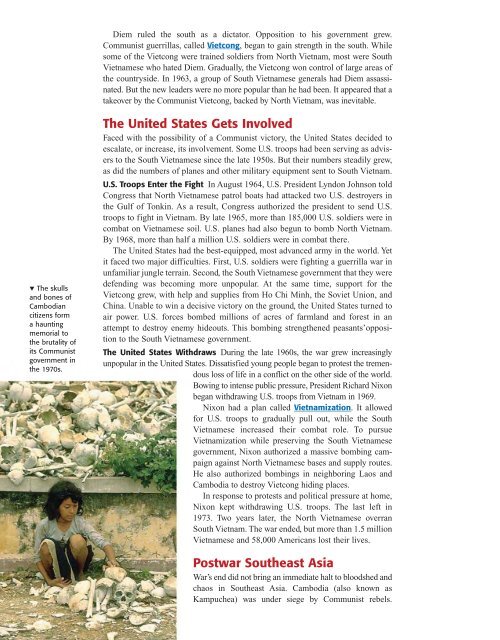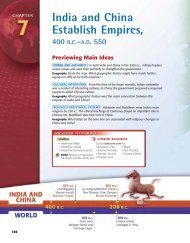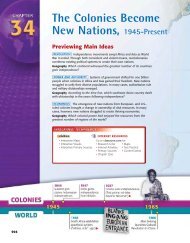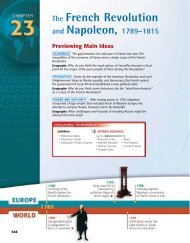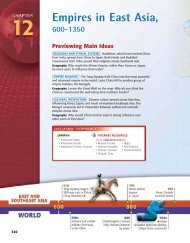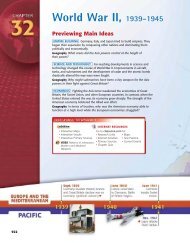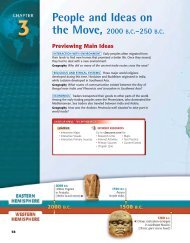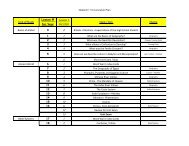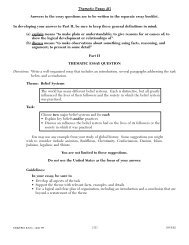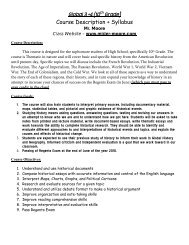Restructuring the Postwar World, - First
Restructuring the Postwar World, - First
Restructuring the Postwar World, - First
You also want an ePaper? Increase the reach of your titles
YUMPU automatically turns print PDFs into web optimized ePapers that Google loves.
▼ The skulls<br />
and bones of<br />
Cambodian<br />
citizens form<br />
a haunting<br />
memorial to<br />
<strong>the</strong> brutality of<br />
its Communist<br />
government in<br />
<strong>the</strong> 1970s.<br />
Diem ruled <strong>the</strong> south as a dictator. Opposition to his government grew.<br />
Communist guerrillas, called Vietcong, began to gain strength in <strong>the</strong> south. While<br />
some of <strong>the</strong> Vietcong were trained soldiers from North Vietnam, most were South<br />
Vietnamese who hated Diem. Gradually, <strong>the</strong> Vietcong won control of large areas of<br />
<strong>the</strong> countryside. In 1963, a group of South Vietnamese generals had Diem assassinated.<br />
But <strong>the</strong> new leaders were no more popular than he had been. It appeared that a<br />
takeover by <strong>the</strong> Communist Vietcong, backed by North Vietnam, was inevitable.<br />
The United States Gets Involved<br />
Faced with <strong>the</strong> possibility of a Communist victory, <strong>the</strong> United States decided to<br />
escalate, or increase, its involvement. Some U.S. troops had been serving as advisers<br />
to <strong>the</strong> South Vietnamese since <strong>the</strong> late 1950s. But <strong>the</strong>ir numbers steadily grew,<br />
as did <strong>the</strong> numbers of planes and o<strong>the</strong>r military equipment sent to South Vietnam.<br />
U.S. Troops Enter <strong>the</strong> Fight In August 1964, U.S. President Lyndon Johnson told<br />
Congress that North Vietnamese patrol boats had attacked two U.S. destroyers in<br />
<strong>the</strong> Gulf of Tonkin. As a result, Congress authorized <strong>the</strong> president to send U.S.<br />
troops to fight in Vietnam. By late 1965, more than 185,000 U.S. soldiers were in<br />
combat on Vietnamese soil. U.S. planes had also begun to bomb North Vietnam.<br />
By 1968, more than half a million U.S. soldiers were in combat <strong>the</strong>re.<br />
The United States had <strong>the</strong> best-equipped, most advanced army in <strong>the</strong> world. Yet<br />
it faced two major difficulties. <strong>First</strong>, U.S. soldiers were fighting a guerrilla war in<br />
unfamiliar jungle terrain. Second, <strong>the</strong> South Vietnamese government that <strong>the</strong>y were<br />
defending was becoming more unpopular. At <strong>the</strong> same time, support for <strong>the</strong><br />
Vietcong grew, with help and supplies from Ho Chi Minh, <strong>the</strong> Soviet Union, and<br />
China. Unable to win a decisive victory on <strong>the</strong> ground, <strong>the</strong> United States turned to<br />
air power. U.S. forces bombed millions of acres of farmland and forest in an<br />
attempt to destroy enemy hideouts. This bombing streng<strong>the</strong>ned peasants’opposition<br />
to <strong>the</strong> South Vietnamese government.<br />
The United States Withdraws During <strong>the</strong> late 1960s, <strong>the</strong> war grew increasingly<br />
unpopular in <strong>the</strong> United States. Dissatisfied young people began to protest <strong>the</strong> tremendous<br />
loss of life in a conflict on <strong>the</strong> o<strong>the</strong>r side of <strong>the</strong> world.<br />
Bowing to intense public pressure, President Richard Nixon<br />
began withdrawing U.S. troops from Vietnam in 1969.<br />
Nixon had a plan called Vietnamization. It allowed<br />
for U.S. troops to gradually pull out, while <strong>the</strong> South<br />
Vietnamese increased <strong>the</strong>ir combat role. To pursue<br />
Vietnamization while preserving <strong>the</strong> South Vietnamese<br />
government, Nixon authorized a massive bombing campaign<br />
against North Vietnamese bases and supply routes.<br />
He also authorized bombings in neighboring Laos and<br />
Cambodia to destroy Vietcong hiding places.<br />
In response to protests and political pressure at home,<br />
Nixon kept withdrawing U.S. troops. The last left in<br />
1973. Two years later, <strong>the</strong> North Vietnamese overran<br />
South Vietnam. The war ended, but more than 1.5 million<br />
Vietnamese and 58,000 Americans lost <strong>the</strong>ir lives.<br />
<strong>Postwar</strong> Sou<strong>the</strong>ast Asia<br />
War’s end did not bring an immediate halt to bloodshed and<br />
chaos in Sou<strong>the</strong>ast Asia. Cambodia (also known as<br />
Kampuchea) was under siege by Communist rebels.


